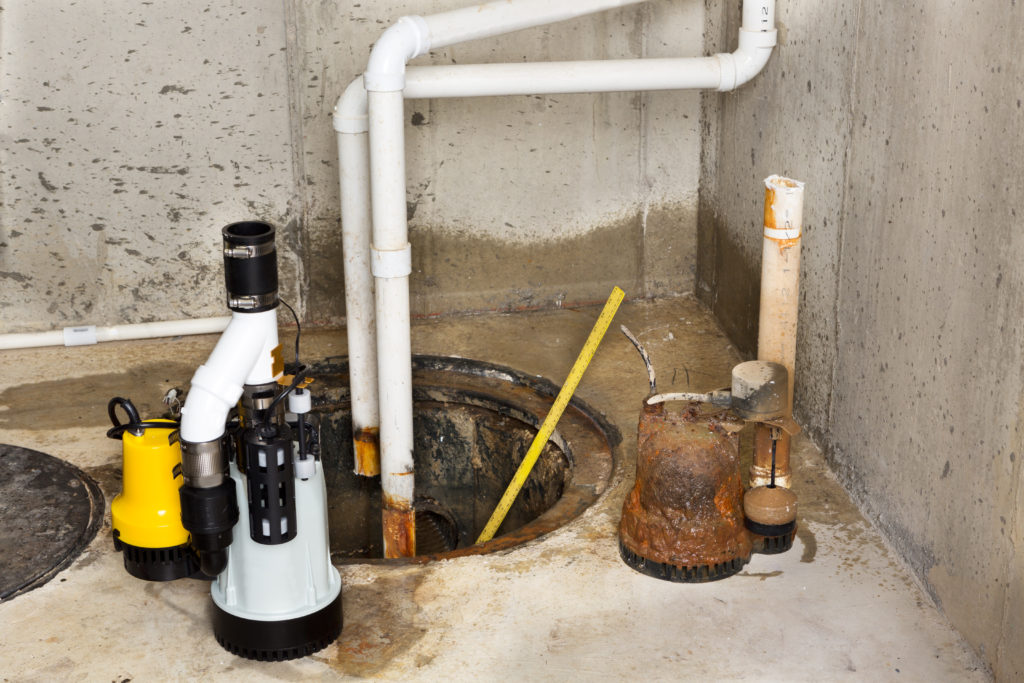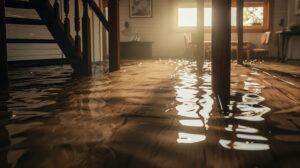When we are called to inspect a water-damaged basement to determine the need for waterproofing, the first thing we do is check the sump pump. In most cases, it is not working properly and the homeowners are unaware of its malfunction. As a result, we wrote this article.
A sump pump is a crucial component of a home’s drainage system, especially for those living in areas prone to flooding or heavy rainfall. It is responsible for preventing water from accumulating in the basement or crawlspace, protecting your home from potential water damage. But how does a sump pump work? In this blog, we will delve into the inner workings of a sump pump, its different types, and how to maintain it for optimal performance.
How a Sump Pump Works
In order for a sump pump to work properly, it must be installed in a sump pit, a hole dug in the lowest part of the foundation of your home. The sump pump is activated when water accumulates in the pit, and it pumps out the water and sends it away from your house. The sump pump is activated by a float switch, which is a buoyant device that rises and falls with the water level.

The sump pump is activated by a float switch, which is a buoyant device that rises and falls with the water level. When the water level reaches a certain point, the float switch triggers the sump pump to turn on. The impeller then begins to move, creating suction that sucks in water and pushes it out through a discharge pipe. The water is typically pumped out to a safe location, such as a storm drain or a dry well.
Types of Sump Pumps
There are three main types of sump pumps – primary, backup, and battery-operated.
Primary sump pumps are the most common type and are designed to handle the normal amount of water that accumulates in your sump pit. They are usually installed in new homes or when a homeowner is replacing an old sump pump.
Backup sump pumps are installed as a secondary measure to protect your home in case the primary sump pump fails. They can be either electric or water-powered. An electric backup sump pump is connected to a power outlet and activates when the primary sump pump fails or when the water level reaches a certain point. A water-powered backup sump pump uses the pressure of the water in your home’s plumbing to pump out the water in the sump pit.
Battery-operated sump pumps are powered by a battery and are used as a backup in case of a power outage. They are usually smaller and less powerful than primary or backup sump pumps, but they provide an added layer of protection for your home.
Maintaining Your Sump Pump
If you live in an area prone to flooding or have a basement prone to water damage, you may have a sump pump installed in your home. These handy devices help to pump water out of your basement or crawl space to prevent flooding and water damage. However, like any appliance, sump pumps require regular maintenance to ensure they are functioning properly and able to handle the job they were designed for.
Here are some tips for maintaining your sump pump to keep it working efficiently and effectively.
Check the Float Switch
The float switch is a critical component of your sump pump, as it is responsible for turning the pump on and off. When the water level in the sump pit reaches a certain point, the float switch will trigger the pump to turn on and start pumping the water out. If the float switch is not working properly, your sump pump may not turn on when it should, or it may turn on and off erratically.
To check the float switch, fill the sump pit with water until it reaches the level where the float switch is supposed to turn the pump on. If the pump does not turn on, there may be an issue with the float switch. You can try adjusting the switch to a different position or replacing it if it appears to be damaged.
Clean the Sump Pit
The sump pit is the area where the pump is located and where the water is collected before being pumped out. It is important to keep the sump pit clean to ensure the pump is able to work efficiently. Debris and sediment can build up in the pit and block the pump from functioning properly.
To clean the sump pit, remove the pump and any debris that may have accumulated in the pit. Use a hose to wash out the pit and remove any sediment that may have built up. Be sure to clean the inlet and outlet of the pump as well to ensure proper water flow.
Check the Voltage
Your sump pump may not be working properly if it is not receiving the proper voltage. It is important to check the voltage of your sump pump to ensure it is operating at the correct level. If the voltage is too low, the pump may not have enough power to function effectively. On the other hand, if the voltage is too high, it can cause the pump to burn out or malfunction.
To check the voltage of your sump pump, use a voltage meter to measure the voltage at the outlet where the pump is plugged in. The voltage should be within the range specified by the manufacturer. If the voltage is outside of this range, it may be necessary to have an electrician check the wiring to ensure it is in good condition.
Replace the Pump Every 5-7 Years
Even with proper maintenance, sump pumps do have a limited lifespan. It is recommended to replace your sump pump every 5-7 years to ensure it is functioning properly. If your pump is older than this, it is a good idea to consider replacing it.
When replacing your sump pump, be sure to choose a high-quality pump that is suitable for your specific needs. Look for a pump with a good warranty and consider purchasing one with a battery backup system in case of a power outage.
Test the Pump Regularly
To ensure your sump pump is working properly, it is a good idea to test it regularly. You can do this by filling the sump pit with water and observing the pump as it turns on and starts pumping the water out. If the pump does not turn on or seems to be struggling to pump the water out, there may be an issue that needs to be addressed.



